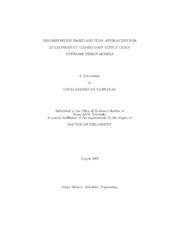| dc.description.abstract | Closed-loop supply chain (CLSC) management provides opportunity for cost
savings through the integration of product recovery activities into traditional supply
chains. Product recovery activities, such as remanufacturing, reclaim a portion of the
previously added value in addition to the physical material.
Our problem setting is motivated by the practice of an Original Equipment Manufacturer
(OEM) in the automotive service parts industry, who operates a well established
forward network. The OEM faces customer demand due to warranty and
beyond warranty vehicle repairs. The warranty based demand induces part returns.
We consider a case where the OEM has not yet established a product recovery network,
but has a strategic commitment to implement remanufacturing strategy. In
accomplishing this commitment, complications arise in the network design due to activities
and material movement in both the forward and reverse networks, which are
attributed to remanufacturing. Consequently, in implementing the remanufacturing
strategy, the OEM should simultaneously consider both the forward and reverse flows
for an optimal network design, instead of an independent and sequential modeling approach.
In keeping with these motivations, and with the goal of implementing the
remanufacturing strategy and transforming independent forward and reverse supply
chains to CLSCs, we propose to investigate the following research questions: 1. How do the following transformation strategies leverage the CLSC?s overall cost
performance?
? Extending the already existing forward channel to incorporate reverse
channel activities.
? Designing an entire CLSC network.
2. How do the following network flow integration strategies influence the CLSC?s
overall cost performance?
? Using distinct forward and reverse channel facilities to manage the corresponding
flows.
? Using hybrid facilities to coordinate the flows.
In researching the above questions, we address significant practical concerns in
CLSC network design and provide cost measures for the above mentioned strategies.
We also contribute to the current literature by investigating the optimal CLSC network
design. More specifically, we propose three models and develop mathematical
formulations and novel solution approaches that are based on decomposition techniques,
heuristics, and meta-heuristic approaches to seek a solution that characterizes
the configuration of the CLSC network, along with the coordinated forward and
reverse flows. | en |



